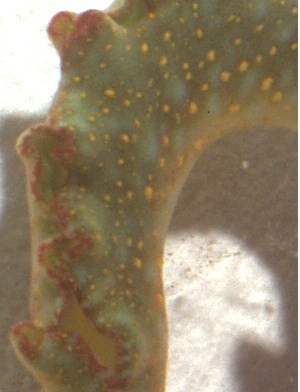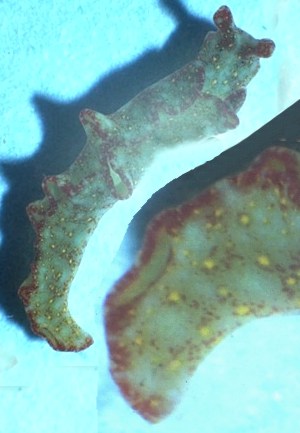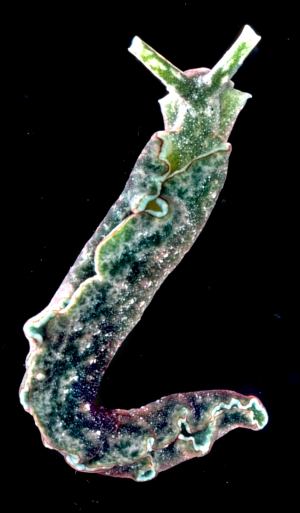
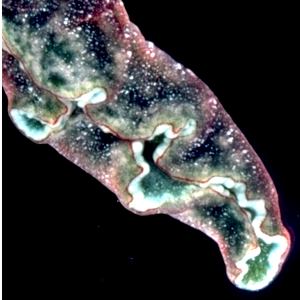
Elysia bennettae
Thompson, 1973
Order: SACOGLOSSA
Superfamily: ELYSIOIDEA
Family: Elysiidae
DISTRIBUTION
Southwestern Pacific - but see comment below and message from Lombok, Indonesia.
PHOTO
One of a number of animals found on the reef flat at Heron Is, Queensland, 9 June 1983. AM C138554. 37mm long alive. Note red tinge on parapodia, caused by small red specks scattered all over the external surfaces of the body, and red line along parapodial edge. Photos: Bill Rudman
The algal chloroplasts within the ducts of the digestive gland give the whole animal a green colouration. Microscopic red specks cover the skin and there is a red line along the edge of the parapodia. The skin also has scattered white mottling. Described from Heron Id, on the tropical east coast of Australia, it has also been reported from Guam (Carlson & Hoff, 1978) but Marshall & Willan (1999) suggest the Guam specimens are Elysia kushimotoensis, a species which is probably a synonym of Elysia rufescens. The geographical distribution of this species, and it colour variability, will depend on just how variable we consider this species to be. Animals with the 'typical' colour form are known from tropical eastrn Australia and nearby waters. Can grow to approx 60mm but seldom more than 40mm long. Reported by Marshall & Willan (1999) to emerge at night to feed on the filamentous green alga Chlorodesmis fastigiata.
There are a number of quite similar red-specked species reported from different parts of the Indo-West Pacific. See photos below of red speckled specimens, which may or may not be this species, from Indonesia, east Africa, and northern New South Wales.
References:
• Carlson, C.H. & Hoff, P.J. (1978) The identifiable Elysia from Guam (Elysiidae, Sacoglossa, Opisthobranchia). Micronesica, 14: 89-113.
• Marshall, J.G. & Willan, R.C., 1999. Nudibranchs of Heron Island, Great Barrier Reef.
• Thompson, T.E. (1973) Sacoglossan gastropod molluscs from eastern Australia. Proceedings of the Malacological Society of London, 40: 239-251.
Rudman, W.B., 2002 (November 18) Elysia bennettae Thompson, 1973. [In] Sea Slug Forum. Australian Museum, Sydney. Available from http://www.seaslugforum.net/find/elysbenn
Related messages
Elysia bennettae from eastern Australia
June 19, 2007
From: Lynda Clarke
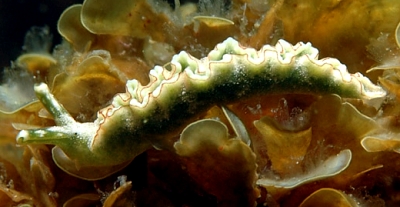
Hi Bill,
Could you please help us to identify this nudibranch, which was photographed by my buddy.
Locality: Julian Rocks, 10 to 15 metres, New South Wales, Australia, Pacific, 2nd February 2007, rocky reef, temp= 26 degrees. Length: about 2 to 3cms. Photographer: John Natoli.
thanks
Lynda
polymath@bigpond.com
Clarke, L., 2007 (Jun 19) Elysia bennettae from eastern Australia. [Message in] Sea Slug Forum. Australian Museum, Sydney. Available from http://www.seaslugforum.net/find/19397Dear Lynda,
I am pretty sure this is Elysia bennettae. The thin red line along the parapodial margin is quite characteristic
Best wishes,
Bill Rudman
Elysia bennettae? from sthn Queensland
August 8, 2006
From: Denis Riek
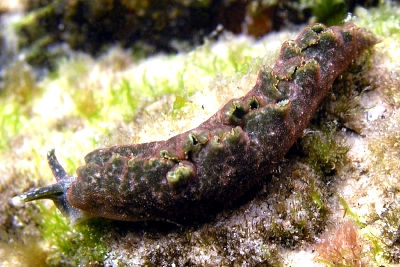
Concerning message #17307:
Dear Bill,
Here are some images of what may be Elysia bennettae from Hastings Point, northern New South Wales. It was found intertidally in a rock pool amongst filamentous green alga as mentioned in your fact sheet but I don't know what species. The animal is a dark colour but has the red spots over the skin.
Locality: Hastings Point, Intertidal, Northern New South Wales, Australia, Pacific, 26 November 2004, On alga on sand in rock pool. Length: 45 mm. Photographer: Denis Riek.
Denis
dwriek@optusnet.com

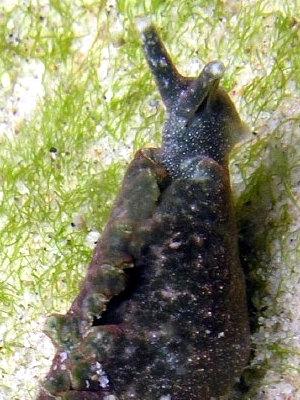
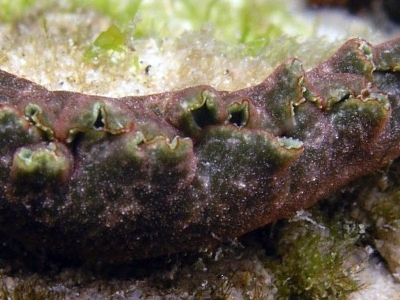
Dear Denis,
Another record of 'typical' examples of this species are very welcome. This is definitely the animal as described by Tom Thompson. One characteristic is the single red line at the parapodial edge.
Best wishes,
Bill Rudman
Elysia bennettae? from sthn Queensland
August 4, 2006
From: Bruce Wilkie
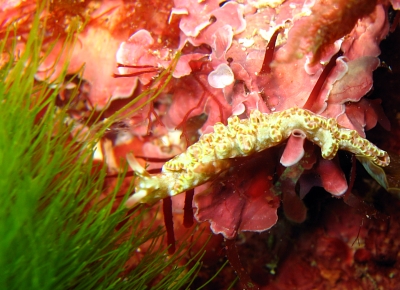
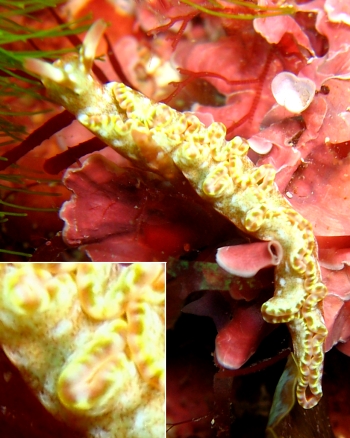
Hi Bill,
I am not sure if I am correct about the id of this animal which I think could be Elysia bennettae (northern New South Wales colour form).
Locality: Flat Rock North Stradbroke Island, 10 metres, Queensland Australia, Pacific ocean, 30 July 2006, rocky reef with sponges, hard & soft corals . Length: 20mm. Photographer: Bruce Wilkie.
Unfortunately I only managed to take 2 so-so frames before the surge got the better me.
Many Thanks
Bruce Wilkie.
brucedwilkie@yahoo.com.au
Wilkie,B, 2006 (Aug 4) Elysia bennettae? from sthn Queensland. [Message in] Sea Slug Forum. Australian Museum, Sydney. Available from http://www.seaslugforum.net/find/17307
Dear Bruce,
Your animal is indeed the same as the one I have posted from northern New South Wales [message #8460]. Apart from the differences mentioned there, we can also add the alternate white and red marks along the parapodial edge. I am not sure if there is one or more species, but there certainly seems that there may be.
Best wishes,
Bill Rudman
Elysia bennettae from Lord Howe Island
January 26, 2003
From: W.B. Rudman

Here is a photo record from Ian Hutton of an animal I am tentatively identifying as Elysia bennettae from Lord Howe Island.
Location: Middle Beach.
It is possibly a different species, because it has quite distinctive light patching along the parapodial edge. Interestingly in a photos of mine show an animal from northern New South Wales, with identical markings. The marine fauna of Lord Howe Island has close similarities to the fauna of the New South Wales section of eastern Australia.
Bill Rudman
Elysia bennettae? on 'live rock'
January 1, 2003
From: Timothy D. Loyd
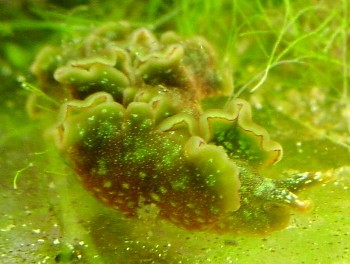
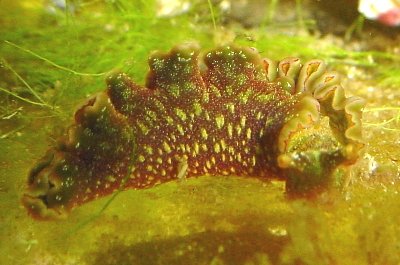
Dear Dr. Rudman,
I have another identification question. I am pretty sure this Nudibranch is an Elysia bennettae, but I wanted to confirm it. It popped up in a refugium that I had some Maidens Hair (Chlorodesmis fastigiata). I presume it was on the rock when it was removed from the ocean and only recently grew to a noticable size. Also it deposited several spirals of yellow eggs. I am guessing that these would not be fertile, but I know very little about the reproductive aspects of nudibranchs.
I am in Knoxville, TN at the Aquarium. The Maidens hair came from Fiji, so this is likely where the Elysia came from as well. Just to mention, I would never intentionally remove a nudibranch from the wild. However, I do see probably a hundred or so a year that end up in our systems. A lot of them are maybe a centimeter long at the most, but occaisionally I see some larger ones. I only bother you with the more interesting specimens. Occasionally they
reproduce in our tanks as well.
P.S. That solid black limpet I contacted you about a couple of years ago has populated all of our tanks with offspring.
Thanks for the info,
Timothy Loyd
tim@aquariumconnection.com
Loyd, T., 2003 (Jan 1) Elysia bennettae? on 'live rock'. [Message in] Sea Slug Forum. Australian Museum, Sydney. Available from http://www.seaslugforum.net/find/8709Dear Timothy,
It certainly looks like E. bennettae. It is quite interesting how many of these 'delicate' animals survive quite rough treatment. Although not a slug, I am interested in hearing about your unplanned Scutus breeding experiment. We know so little about reproductive behaviour in marine molluscs that any little bit of information is valuable.
Best wishes,
Bill Rudman
Elysia bennettae? from Indonesia
November 22, 2002
From: Felix Villares
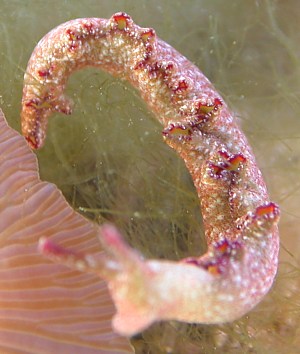
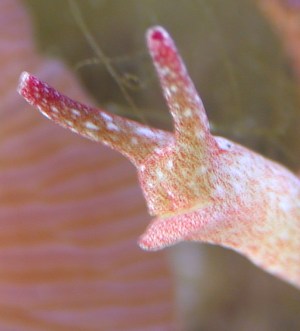
Dear Bill,
I found this specimen in my tank. I think it belongs to genera Elysia, may be species E. ornata or Elysia sp.11. I tried to find out the origin of this organism by asking the provider but he only knows the place of the samples came from (Lombok, Indonesia). It feeds on Hymedesmia and Derbessia algae. If somebody can give me any clues about this sea slug I would much appreciate it.
Felix Villares
elbuzo@guay.com
Villares, F., 2002 (Nov 22) Elysia bennettae? from Indonesia. [Message in] Sea Slug Forum. Australian Museum, Sydney. Available from http://www.seaslugforum.net/find/8388Dear Felix,
Are you sure of the locality? This looks very like Elysia bennettae, which is another species I had not, until now, posted on the Forum. Elysia bennettae is quite easily recognisable from the small red specks all over the body and parapodia, the white spots, and the red edge to the parapodia and rhinophores. However the 'typical' colour form of this species has only previously been reported from eastern Australia and nearby waters. I have added some messages showing similarly coloured animals from east Africa and subtropical eastern Australia. Your animal also has similarities to the one I describe from nothern New South Wales. I don't know if this means the species is more variable than we thought or whether there are a number of similarly coloured species. Your photos are quite interesting, though it would be good to get confirmation of where your animal is from.
Best wishes,
Bill Rudman
Elysia bennettae from Heron Island
November 22, 2002
From: Bill Rudman


To accompany Felix Villares' photo from Lombok, Indonesia, here is a photo of a 'typical' specimen of Elysia bennettae from the type locality, Heron Island, where it is very common.
PHOTO: One of a number of animals found on the reef flat at Heron Is, Queensland, 9 June 1983. 37mm long alive. AM C138554. Red specks scattered all over the external surfaces of the body. Photo: Bill Rudman.
Note the red tinge all over the parapodia, which is caused by the microscopic red specks, and note the red line along the parapodial edge.
Best wishes,
Bill Rudman
Elysia bennettae? from northern New South Wales
November 22, 2002
From: Bill Rudman
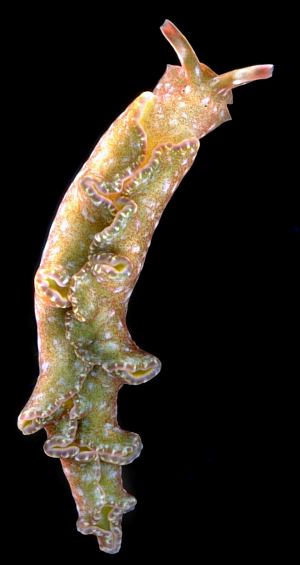
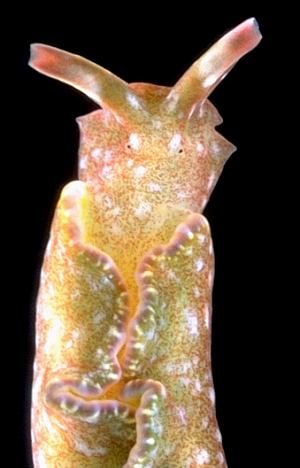
This animal differs from 'typical' Elysia bennettae in that the red specks are larger, and do not aggregate along the edge of the parapodia or the tip of the rhinophores to form a red line. It also has a yellow submarginal band on the inside of the parapodia.
PHOTOS: South Solitary Is, Coffs Harbour, New South Wales, Australia. Depth: 21m. February 1987. Length: 32mm. AM C152549. Photos: Bill Rudman.
Best wishes,
Bill Rudman
Elysia bennettae? from east Africa
November 22, 2002
From: Bill Rudman
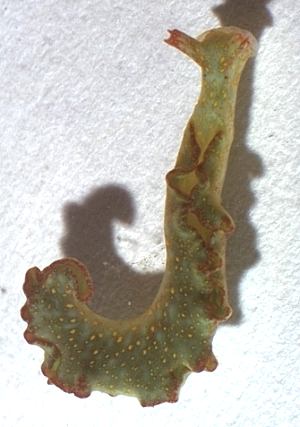
Here are some photos of a species which has the microscopic red specks of Elysia bennettae, but differs in having the red specks arranged in a reticulate pattern, and in having large yellow spots arranged in the reticulate pattern. Basically the animal is green with a reticulate pattern of red specks. Within the red reticulations are large yellow spots. The edge of the parapodia and rhinophores are red, but the red line along the edge of the parapodia is much broader than in E. bennettae.
PHOTOS: Upper Right, Lower Left: Msasani Bay, Dar es Salaam, Tanzania, Intertidal, 18 September 1974, off green algae. Lower Right: Ladder Cove, Dar es Salaam, Tanzania, Intertidal, 2 August 1974. Length of both animals 17mm long alive. Photos: Bill Rudman
I will leave it with Elysia bennettae until we know more about these red speckled species.
Best wishes,
Bill Rudman
